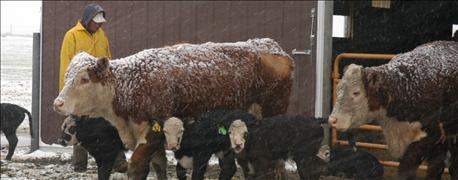April 21, 2016

Movie star Bo Derek may have been a “10,” but your mature cows better be at least a “5.” Heifers need to be at least a “6.”
Body condition scoring at calving is a critical measure so take a close look at the cows when you tag the calves, advises Ken Olson, South Dakota State University Extension beef specialist.
Anything less than a Body Condition Score (BCS) of 5 is not good.

Checking cow conditon scores at calving is as important as tagging the calves.
“Managing cow nutritional status from now until adequate green grass will become very important to ensure cows will be cycling and fertile when the breeding season starts,” he says. “There is strong evidence that cows with a moderate BCS of 5 (on a scale of 1 to 9) will be more likely to restart estrous cycles before breeding and more likely to get pregnant than cows in thinner BCS (less than 5).
As calving season progresses, keep track of the running average of the BCS of the cows, Olson suggests.
“If the running average is 5 or better, the cows are in great shape and it will be a simple matter of feeding them adequately to maintain BCS. If the running average is less than 5, then the feeding program should be modified to give them the opportunity to gain BCS before breeding begins,”
If the running average is decreasing as time goes on, the cows are in a negative energy balance and pulling fat off their bodies, or losing BCS.
“For example, let’s say the running average after the first week of calving is 5.2, but at the end of the second week it is a 5.1, and by the end of the third week it is 4.9. In this example, there is evidence that BCS is slipping. An average BCS of 4.9 seems close enough to 5 to consider the herd to be at the status you want, but the problem is that it needs to remain there until breeding and the fact that the running average is declining suggests that it will not. Therefore, this is an indicator that your feeding program should be adjusted to provide the nutrients to gain body weight and therefore body condition.”
What about first-calf heifers?
First-calf heifers are the group that is most likely to lose BCS after calving. They are young and still growing while lactating for the first time. This creates greater nutritional challenges for them than mature cows and makes them more likely to fail to have adequate nutritional status to be reproductively sound when breeding begins.
“I recommend that it is even more important to keep records on them of BCS status over time and make appropriate adjustments. Abundant research suggests that first-calf heifers should be at a BCS of 6 (rather than the BCS of 5 suggested for mature cows) and that they should gain BCS after calving, even if they were at 6 at calving. Keeping them separate from the mature cows is an important step in this process. They cannot compete at the feed bunk with larger, older cows and will get cheated out of their share of feed and supplements. Additionally, keeping them separate will allow the opportunity to adjust their diet if needed, and not have to provide additional, unneeded feed to the mature cows.”
Feeding Considerations
There is an abundance of feedstuffs that can be used to improve nutrient intake if needed, Olson says.
"These include distiller’s grains, wheat midds and a large variety of other byproducts and commodities. Good to high quality hay can also be used as a supplement to improve nutrition. Fortunately, the prices on almost all of these feedstuffs have dropped dramatically in recent years. Wise shopping can lead to improved nutrition at the best possible price. Nutritionists can play a critical role in determining which feedstuff provides the needed nutrients at the best price," Olson says.
Source: SDSU Extension
You May Also Like




